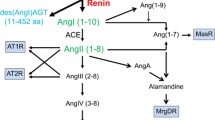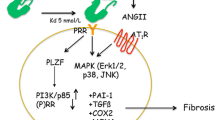Abstract
Many extracellular signaling proteins act within their cells of synthesis and/or in target cells after internalization. This type of action is called intracrine and it plays a role in diverse biological processes. The mechanisms of intracrine intracellular action are becoming clear thanks to the application of modern techniques of molecular biology. Here, progress in this area is reviewed. In particular the intracrine biology of angiotensin II is discussed.
Access this chapter
Tax calculation will be finalised at checkout
Purchases are for personal use only
Similar content being viewed by others
References
Robertson AL Jr, Khairallah PA (1971) Angiotensin II: rapid localization in nuclei of smooth and cardiac muscle. Science 172:1138–1139
Re RN, MacPhee AA, Fallon JT (1981) Specific nuclear binding of angiotensin II by rat liver and spleen nuclei. Clin Sci (Lond) 61:245S–247S
Re R, Parab M (1984) Effect of angiotensin II on RNA synthesis by isolated nuclei. Life Sci 34:647–651
Re RN, LaBiche RA, Bryan SE (1983) Nuclear-hormone mediated changes in chromatin solubility. Biochem Biophys Res Commun 110:61–68
Re RN, Vizard DL, Brown J et al (1984) Angiotensin II receptors in chromatin fragments generated by micrococcal nuclease. Biochem Biophys Res Commun 119:220–227
Re RN, Vizard DL, Brown J et al (1984) Angiotensin II receptors in chromatin. J Hypertens Suppl 2:S271–S273
Re R, Bryan SE (1984) Functional intracellular renin-angiotensin systems may exist in multiple tissues. Clin Exp Hypertens A 6:1739–1742
Cook JL, Zhang Z, Re RN (2001) In vitro evidence for an intracellular site of angiotensin action. Circ Res 89:1138–1146
Cook JL, Giardina JF, Zhang Z et al (2002) Intracellular angiotensin II increases the long isoform of PDGF mRNA in rat hepatoma cells. J Mol Cell Cardiol 34:1525–1537
Cook JL, Mills SJ, Naquin R et al (2006) Nuclear accumulation of the AT1 receptor in a rat vascular smooth muscle cell line: effects upon signal transduction and cellular proliferation. J Mol Cell Cardiol 40:696–707
Cook JL, Mills SJ, Naquin RT et al (2007) Cleavage of the angiotensin II type 1 receptor and nuclear accumulation of the cytoplasmic carboxy-terminal fragment. Am J Physiol Cell Physiol 292:C1313–C1322
Redding KM, Chen BL, Singh A et al (2010) Transgenic mice expressing an intracellular fluorescent fusion of angiotensin II demonstrate renal thrombotic microangiopathy and elevated blood pressure. Am J Physiol Heart Circ Physiol 298:H1807–H1818
Cook JL, Re RN (2011) Lessons from in vitro studies and a related intracellular angiotensin II transgenic mouse model. Am J Physiol Regul Integr Comp Physiol 302:R482–R493
Re RN, Cook JL (2011) Noncanonical intracrine action. J Am Soc Hypertens 5:435–448
Abadir PM, Foster DB, Crow M et al (2011) Identification and characterization of a functional mitochondrial angiotensin system. Proc Natl Acad Sci U S A 108:14849–14854
Premer C, Lamondin C, Mitzey A et al (2013) Immunohistochemical localization of AT1a, AT1b, and AT2 angiotensin II receptor subtypes in the rat adrenal, pituitary, and brain with a perspective commentary. Int J Hypertens 2013:175428. doi:10.1155/2013/175428
Cook JL, Singh A, DeHaro D et al (2011) Expression of a naturally occurring angiotensin AT(1) receptor cleavage fragment elicits caspase-activation and apoptosis. Am J Physiol Cell Physiol 301:C1175–C1185
Tadevosyan A, Vaniotis G, Allen BG et al (2012) G protein-coupled receptor signalling in the cardiac nuclear membrane: evidence and possible roles in physiological and pathophysiological function. J Physiol 590:1313–1330
Re RN (2002) The origins of intracrine hormone action. Am J Med Sci 323:43–48
Re RN (2003) The intracrine hypothesis and intracellular peptide hormone action. Bioessays 25:401–409
Re RN, Cook JL (2006) The intracrine hypothesis: an update. Regul Pept 133:1–9
Re RN, Cook JL (2008) The basis of an intracrine pharmacology. J Clin Pharmacol 48:344–350
Re RN, Cook JL (2009) Senescence, apoptosis, and stem cell biology: the rationale for an expanded view of intracrine action. Am J Physiol Heart Circ Physiol 297:H893–H901
Re RN, Cook JL (2010) The mitochondrial component of intracrine action. Am J Physiol Heart Circ Physiol 299:H577–H583
Re RN (2011) Lysosomal action of intracrine angiotensin II. Focus on “Intracellular angiotensin II activates rat myometrium”. Am J Physiol Cell Physiol 301:C553–C554
Kumar R, Thomas CM, Yong QC et al (2012) The intracrine renin-angiotensin system. Clin Sci (Lond) 123:273–284
Re RN (2013) Could intracrine biology play a role in the pathogenesis of transmissible spongiform encephalopathies, Alzheimer’s Disease, and other neurodegenerative diseases? Am J Med Sci 347:312–320
Author information
Authors and Affiliations
Corresponding author
Editor information
Editors and Affiliations
Rights and permissions
Copyright information
© 2015 Springer Science+Business Media New York
About this protocol
Cite this protocol
Re, R.N., Cook, J.L. (2015). Studies of Intracellular Angiotensin II. In: Allen, B., Hébert, T. (eds) Nuclear G-Protein Coupled Receptors. Methods in Molecular Biology, vol 1234. Humana Press, New York, NY. https://doi.org/10.1007/978-1-4939-1755-6_1
Download citation
DOI: https://doi.org/10.1007/978-1-4939-1755-6_1
Published:
Publisher Name: Humana Press, New York, NY
Print ISBN: 978-1-4939-1754-9
Online ISBN: 978-1-4939-1755-6
eBook Packages: Springer Protocols




